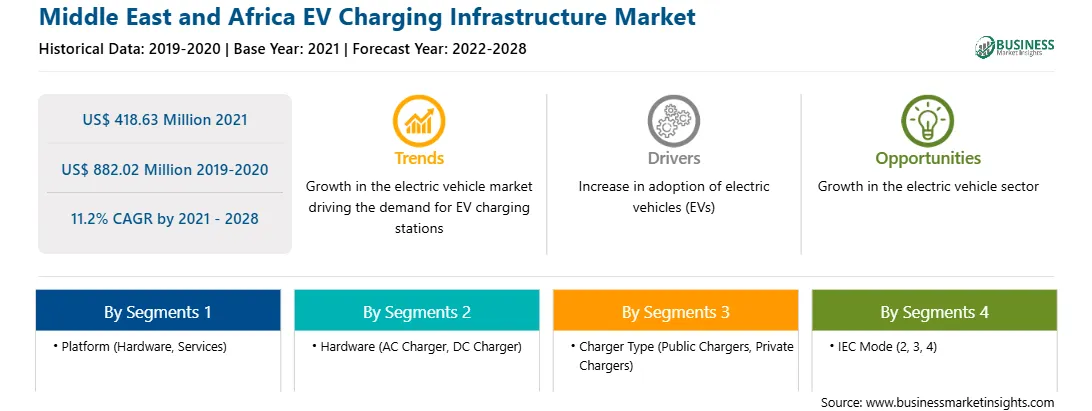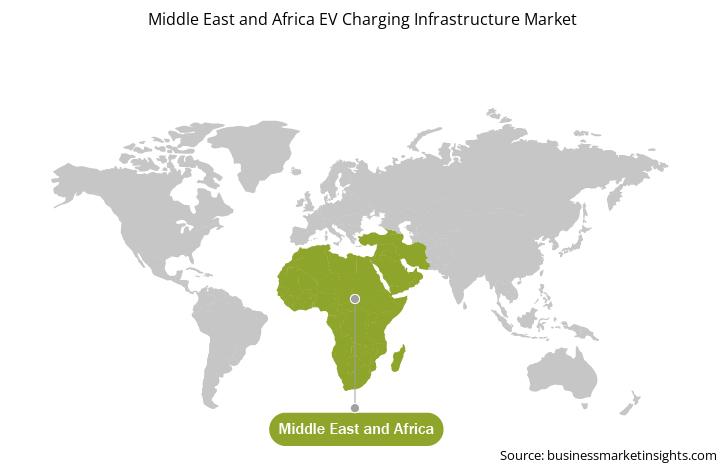Middle East and Africa EV Charging Infrastructure Market
No. of Pages: 161 | Report Code: TIPRE00028695 | Category: Automotive and Transportation
No. of Pages: 161 | Report Code: TIPRE00028695 | Category: Automotive and Transportation
Presently, EV charging stations are more common in private residences. However, the rising consumer demand has led to an active adoption of on-site commercial charging as a standard building feature. Several countries across the region are expected to implement charging in residential and commercial buildings to scale up the EV charging infrastructure soon, which requires upgrading buildings' electrical infrastructure to satisfy the rising demand for EV charging. Additionally, EV charging at scale is subject to the careful planning of a building's electrical distribution system, along with the local electric-grid infrastructure. To enhance the accessibility and affordability of electric chargers, many building developers, urban planners, and electrical-equipment suppliers are actively integrating the EV charging infrastructure into standard building design plans. Furthermore, public charging stations in workplaces and dedicated EV charging hubs create a massive opportunity to expand the EV charging infrastructure market, owing to the rising adoption by less affluent buyers, including those residing in multiunit housing (having limited access to in-home charging). Therefore, the increase in the number and type of location of charging infrastructure, beyond single-family homes, to include its installation in apartment complexes, offices, fleet depots, parking lots, and commercial centers, is creating ample growth opportunities for the scaling-up of the EV charging infrastructure market across the region.
Despite the region's oil and fossil fuel wealth, renewable energy remains a top priority for MEAF government entities, motivated by a desire to be leaders in clean transportation technologies and environmental concerns. Favorable government policies and incentives for the uptake of electric vehicles are expected to fuel market growth in the future years, with Saudi Arabia and the UAE leading the way. With 200 Telsa EVs being launched into the Dubai taxi business, the UAE is at the forefront of innovation. This was the first move in Dubai's effort to promote green transportation options, tied to the government's goal of having self-driving vehicles account for 25% of all journeys by 2030. Furthermore, Dubai's two-part approach relies on electric vehicle charging infrastructure. The city is investing in hundreds of charging stations and offering financial incentives to EV users, including free charging and parking until the end of 2022. As a result, the region stands out as the go-to-market for EV charging infrastructure vendors, owing to a number of favorable initiatives and the growing usage of electric vehicles. Furthermore, the Saudi Arabian Standards Organization (SASO) intends to create regulations for the use of electric vehicles. It has indicated that 5% of its parking spots will be reserved exclusively for EVs. This decision is part of Saudi Arabia's overall endeavor to lower its carbon footprint and conserve its energy supplies. Hence, the development of EV charging infrastructure in the region is also aided by such initiatives.
Strategic insights for the Middle East and Africa EV Charging Infrastructure provides data-driven analysis of the industry landscape, including current trends, key players, and regional nuances. These insights offer actionable recommendations, enabling readers to differentiate themselves from competitors by identifying untapped segments or developing unique value propositions. Leveraging data analytics, these insights help industry players anticipate the market shifts, whether investors, manufacturers, or other stakeholders. A future-oriented perspective is essential, helping stakeholders anticipate market shifts and position themselves for long-term success in this dynamic region. Ultimately, effective strategic insights empower readers to make informed decisions that drive profitability and achieve their business objectives within the market.

| Report Attribute | Details |
|---|---|
| Market size in 2021 | US$ 418.63 Million |
| Market Size by 2028 | US$ 882.02 Million |
| Global CAGR (2021 - 2028) | 11.2% |
| Historical Data | 2019-2020 |
| Forecast period | 2022-2028 |
| Segments Covered |
By Platform
|
| Regions and Countries Covered | Middle East and Africa
|
| Market leaders and key company profiles |
The geographic scope of the Middle East and Africa EV Charging Infrastructure refers to the specific areas in which a business operates and competes. Understanding local distinctions, such as diverse consumer preferences (e.g., demand for specific plug types or battery backup durations), varying economic conditions, and regulatory environments, is crucial for tailoring strategies to specific markets. Businesses can expand their reach by identifying underserved areas or adapting their offerings to meet local demands. A clear market focus allows for more effective resource allocation, targeted marketing campaigns, and better positioning against local competitors, ultimately driving growth in those targeted areas.

The MEA EV charging infrastructure market is segmented based on operator type, platform, hardware, charger type, IEC mode, and country.
ABB Ltd.; Blink Charging Co.; BOSCH Auto Parts; Delta Electronics, Inc.; Driivz Ltd.; Eaton; EVBox; Leviton Manufacturing Co., Inc.; Siemens AG; Tesla, Inc.; Tritium; Wallbox Chargers, S.L.; and Webasto Group are the leading companies operating in the MEA EV charging infrastructure market.
The Middle East and Africa EV Charging Infrastructure Market is valued at US$ 418.63 Million in 2021, it is projected to reach US$ 882.02 Million by 2028.
As per our report Middle East and Africa EV Charging Infrastructure Market, the market size is valued at US$ 418.63 Million in 2021, projecting it to reach US$ 882.02 Million by 2028. This translates to a CAGR of approximately 11.2% during the forecast period.
The Middle East and Africa EV Charging Infrastructure Market report typically cover these key segments-
The historic period, base year, and forecast period can vary slightly depending on the specific market research report. However, for the Middle East and Africa EV Charging Infrastructure Market report:
The Middle East and Africa EV Charging Infrastructure Market is populated by several key players, each contributing to its growth and innovation. Some of the major players include:
The Middle East and Africa EV Charging Infrastructure Market report is valuable for diverse stakeholders, including:
Essentially, anyone involved in or considering involvement in the Middle East and Africa EV Charging Infrastructure Market value chain can benefit from the information contained in a comprehensive market report.